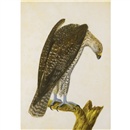Long before Captain George Cartwright enjoyed discussions of hawking in the late 1700, logging Peregrine nest sites in Labrador, or pursuing "favorite amusement" or "his vocation" of hawking (see page XXX, 38, and 262, of his journals, printed 1911), Europeans would have likely taken the sport to Newfoundland. Considering that King Henry the 7th and 8th were ardent falconers (as were their progeny), it is no wonder this treasure was of the most extreme importance to New World explorers and inhabitants. One might even suggest that large falcons were the most valuable commodities on planet earth for many centuries. In fact, while little was recorded of Giovanni Caboto's voyages, one of the first maps ever produced of the New World in 1503, by Sebastian Caboto (his son that had accompanied him on both his voyages of ?1497? and ?1498?) had in a portion of its inscription "...In the same Island also, breeds falcons, so black in their color that they wonderfully resemble ravens...". While this could have been any coastal raptor one could easy contrive that thee hawk of interest, and worthy of inscription on such a document, would be the one(s) that falconers (ie Royalty that fund exploration missions) would desire. Little interest would have been paid to marsh hawks or rough-legged hawks. While perhaps not understood by non-falconers, a black or very dark falcon is very desirable for its ability to be seen while the bird is at great heights. The lighter the color of the falcon the faster is "skys out" (a falconry term used to describe when a falcon is circling so high while hunting that it cannot be seen any longer with the naked eye). Losing sight of one's falcon is a falconers worst nightmare (even in these days of telemetry). However, the higher the falcon hunts the greater command it has of the air and ground under it whereby it's "hunting cone" is dramatically larger. The position of the falcon is critical as it "waits on" overhead. If the falcon is "out of position" (ie down wind in its circular upward spirals) when game is flushed it is less likely to make a pursuit, and even if it does pursue its quarry from a down wind position, it is more likely to fail at securing it. Seeing and thus knowing where one's falcon is while waiting on, and allowing it to gain as much height as possible are often both best achieved by the blackest birds that one can secure. This has not changed in 1000s of years. One might surmise that this is why Mr. Caboto referred to the Newfoundland falcons as "wonderfully" as black as ravens when producing maps for Royal eyes. Even today, Newfoundland and southern Labrador are famous world wide in falconry circles for very dark phase birds, and it seems, that perhaps this might have been so from time immemorial. Perhaps it (falconry) and the desire for new birds was a driving force behind the funding of the exploration of the New World. Certainly one falcon could fetch more wealth than a fleet filled with salted fish that would never grace Royal tables. As far back the the Norse Sagas (ca 1000AD), young men were encouraged to visit and live in Greenland to collect valued trading items such as falcons. It is not surprising to see that, just in time for the return of the subsequent mission of Miguel de Cortereal in 1503, the British Parliment on November 17th 1503 enacted a reward entitled "Falconry, a noble's sport: British Parliament seeks New World falcons" (1503). A reward of one pound was given by King Henry on November 17th "to one that brought haukes from New Founde Island". The year before a similar award was granted for an eagle on September 23rd but it can not be conclusively shown to hae come from Newfoundland as the Island is not mentioned directly. One would imagine that the British government has records of the imports over the subsequent decades (likely to Bristol). This might include the some of the first records of live birds transported from the New World. Sadly, many of the records from 1497 to 1504 have vanished (long story involving the Pope, The Kings of Spain and England, Religion, who actually discovered the New World, and other "political issues"). The reasoning behind such British falcon legislation will be quickly understood if the reader reviews the history and value placed in falcon acquisitions and trading throughout Europe. See eg at :http://users.cybercity.dk/~ccc12787/hist/dk1.html (It was estimated by one early author that every nest site was known in Iceland in the 1600s and populations decreased until finally protected in the mid 1900s). While there is historical evidence of foxes and other "vermin" that competed with "eggers" on the various Newfoundland seabird colonies, one might guess that any "cliff haukes" (an OLD traditional newfoundland slang for a type of hawk dwelling on sea cliffs) and/or peregrine and/or gyrfalcon eyries would have been well guarded secrets worth more than any amount of fox skins, eggs, or salted sea birds collected and thus not shot as competition for egg production. As various "Stinking Islands", "Bird Islands", "White Islands", etc, etc were decimated of their seabird populations around the coast of Newfoundland without record, one might surmise that the "cliff hauwkes" were gathered into oblivion rather than shot or gang blanked into rendering pots. Annual Danish harvests were as high as 100-170 adult birds annually in their realm (Iceland and Greenland). One year over 200 were trapped (it was eventually made illegal to take eyasses). The cities of Valkenwaard in Holland and Flanders in France became dependent on their international falconry trades and members of royal courts from every European country were sent there each fall to bid on birds. An interesting summery of the history of EU falconry can be seen at: http://www.r3.org/life/articles/falconry.html Most probably the British government would have kept records that might still be available today of peregrine and gyrfalcons that were collected in Newfoundland and by whom and where they were collected (eg the Rolls on Trade with Colonies, and other Rolls for collecting fees for falcons under decrees and legislation). One can only guess that no one has ever went looking for such information (falcon import rewards) in recent times; if ever. However, many birds were brought back to Europe in the 16th and 17th centuries (Mackie 1966). One can only wonder if the skins of a "collection" of New Founde Land birds examined by Linnaues and referred to in his 1753 review, contain falcon skins from those that might have perished in the journey or been shot. Since the late 13th century skins had been gathered and stored in the Tower of London and by 1743 Edwards in his 1749 book Natural History of Uncommon Birds refers to a "newfoundland collection" housed in the Tower (seen in Montevecchi and Tulk 1987 and not read first hand). If we are to completely dismiss or at least "need more evidence" than a ship captain's description of a "cliff dwelling falcon" that resides with the sea birds (as the peregrine and gyrs do now in isolated areas of Labrador ), then perhaps we should be looking into the British records of peregrine and gyrfalcons captured from Newfoundland and traded in the 16th and 17th centuries as one might suggest that by the 18th and 19th century they would have went the way of the great auk, sea mink (an extinct NL mustelid as big as an otter), passenger pigeon, eskimo curlew, the 100,000+ walrus that lined our Island's shores, and caribou subherds that roamed our coastal headlands. It is unlikely that the large falcons lasted much longer than the now extinct Newfoundland wolf, which didn't last 100 years with a price on its head that would have amounted to pennies compared to the worth a large falcon at the time. Surely, falcons on exposed cliffs would be much much easier to find than the illusive wolves and much rarer while breeding much slower. Traditionally, falcons were taken as nestlings in Scotland. Actually, it can be suggested that it is primarily due to their value we find little record of their possible trade. An example of the extreme lengths merchants went to to make secret their voyage locations and profits can be seen in Captain Carlilse of his April 1583 voyage in Hakluyt Vol 13 chapter 5 (see link below and note report of 1400 to 1500% profit!). From the 1500 to 1700 falcons streamed in to England from Holland, Norway, Denmark, Ireland, Iceland, and basically wherever they could be found Including all along the Coastal New World. King James I paid 1,000 pounds for a single pair of gyrfalcons (Weldon). With 500 to 1000+ British ships visiting Newfoundland annually and focused to within 30 miles of the coastline, the "foraging and collecting" force available was considerable. This is to say nothing of the 20,000+ men and approximately 300 French vessels annually visiting by the late 1600s. In fact, Newfoundland can be thought of as being more Basque, Spanish, and French then English up until the early 1700s. One must also note that the DANES visited very early on. One only has to read the report of Mr Rice Jones in 1594 (seen in Hakluyt vol 13 chpt 11), of the 80+ ships found in various harbours of St Pierre and southern Newfoundland to begin to understand the exploitation that was occurring in the late 1500s. One might expect the most evidence of falconry related activities would be found in the french history of Newfoundland (which has never been researched). By the late 1650s 15 permanent settlements had been constructed (Anspache 1819) on the Island. By the late 1700s some coastal bird populations were in dire straights. In Drake's 1597 description of walrus harvesting on the Newfoundland south shore he woefully mentions how late the E|nglish are in ramping up efforts to harvest animals from Newfoundland "....haue brought vs true relation of the manifold gaine which the French, Britaynes, Baskes, and Biskaines do yerely returne from the sayd partes; ...". Thomas Pennant failed to find Latham's Newfoundland Falcon instead referring to Latham's description of the bird (See section from Latham's book A General Synopsis of Birds). Later naturalists also failed to find this falcon. Latham also describes in his second works a "likely related falcon" he calls the St.John's Falcon (which was captured with a gyrfalcon) which also was never seen again. However, in his first works he places the Newfoundland Falcon in his list between a variety of gyrfalcn and a variety of a peregrine - much apart from the suspicious St.John's falcon, Placentia falcon, and Forester's "rough-footed falcon" (that Latham suggests may all be marsh hawks but bases this on Bank's drawing - and presumable description - so he is basically repeating Banks but with an objective view concerning Bank's "new species"). One might suggest that the St.John's falcon was a marsh hawk based on "feathered to the toes and strong feet" and perhaps not an arctic variety of peregrine (Latham pg 77). Sadly, a painting of the Newfoundland Falcon was done many years later, does not follow the description very well, and have even been interpreted as being a "black headed" immature goshawk (????) Lysaght 1971. Ms Lysaght, mis-identified the collection location as Labrador and not Croque, Newfoundland in her earlier publication of 1959 but corrected this information in her second book. She notes slight differences (perhaps a re-etching?) between a print she reviewed in Mc Gill and the Print Room Plate and suggested both were likely done by Paillou. Latham and Pennant were indebted to a Father of Ornithology Sir Joseph Banks for his 1766 Newfoundland samples, skins, books, drawings, etc. and they were friends (see on-line sources for original letters between them). Banks was the true initiator of the Newfoundland and St.John's Falcons (Lysaght, 1971). One might suggest that marsh hawks and rough-legged hawks were well known to these naturalists and would not easily be confused for a peregrine or gyrfalcon falcon even at great distances. "Bay Falcons" or other names used to describe subspecies or types of these hawks might not have signified a lack of experience with raptor but conversely the opposite and may show an ability to split raptors into subspecies. However, this author notes that NL breeding marsh hawks (as well as peregrines, gyrs, barred owls, and many others can vary from dark grey to various browns and rufus, to nearly pure white depending on location). The author also notes that marsh hawk habitat is virtually none existent near Croque, Newfoundland, were Banks collected his Newfoundland Falcon, but rather there is habitat conducive to large falcons such as the peregrine. Moreover, while current modern day distribution maps suggest barred owls do not occur in the province, this author has seen many breeding pairs and "flocks" of up to approximately 50 of them migrating south in late August (they are nearly snow white and from the Torngat Mountains). It is little wonder then why many early orinthologists did mention various "new" falcons and hawks. Important birds such as peregrines and gyrfalcons were even more finely divided. Banks described a bird he collected in Labrador as a peregrine. Sir Joseph Banks secured a, possibly, live young eagle (and two skins of adult bald eagles) during his trip to Newfoundland and Labrador. "Advertising" for new subspecies from remote areas were even placed in magazines of the day such as Vol xli pg 297 of Gentleman's Magazine. For the example given above the King of Denmark was said to send for them annually and buy all that could be found. This King employed a "falcon collector" to annually gather birds from resident collectors (Latham 1821 pg 71-72). Base payment to the local harvester was 7 to 15 rixdollars (depending on quality of color) plus a "gift of encouragement" to secure more. The harvest was immense with the birds traded globally and given as gifts. Many pairs of such birds were bought by King James I whom was then in control of his own Island with large Falcons (ie Newfoundland). Falcons were "biologically" described in great details concerning size, location, age, race/"species"/"subspecies", and behaviour and none more so than the much sought after gyrfalcons and peregrines. As evidence of the value placed on pergerines and gyrs, as late as 1764 the Dukes of Atholl were granted the feudal tenancy of the Isle of Man for a ‘rent’ of two white Gyrfalcons, to be paid to each succeeding monarch at his coronation. In the reign of Edward III the theft of a trained bird was punishable with death. 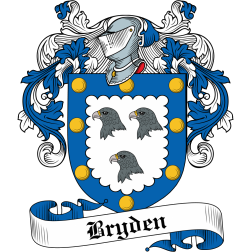 The Heraldic meaning of the Falcon/Hawk is One who does not rest until objective achieved. | 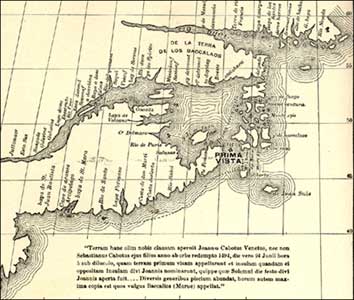 It reads in Latin with the date of 1494: Terram hanc olim nobis clausam, aperuit Ioannes Cabotus Venetus, necno Sebastianus Cabotus eius filius anno ab orbe redem pto 1494 die vero 24 Julij (sic), hora 5 sub diluculo, quá terrá prima visain appellarunt, et Iusulá quandi magná ei oppositá, Insulá divi Io annis nominarunt, quippe quae solemni die festo divi Ioannnis a perta fuit. Huius terrae incolae pellibus animalium induuntur, arcuin in bello, sa gittis, hastis spiculis clavis ligneis, et fundis utuntur, sterilis incultaq tellus fuit, leonibus, ursis albis, procerisque cervis, piscibus innume-ris lupis scilicet, salmonibus, et ingentibus soleis, unius ulnao longitudine, altisque diversis piscium generibus abundat, horum autem maxima copia est, quos vulgus Bacallios appellat, ad haec insunt accipitres nigri corvorum similes, aquilae, perdicesque fusco colore aliaeque diversae volucres. 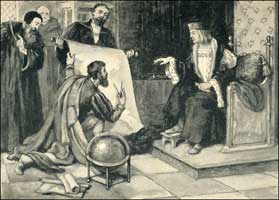 John Cabot explaining his discovery of the New World to King Henry VII (whom was a famous falconer keeping many many birds). His son became King in 1509. Henry VIII - and had very elaborate mews built where the National Gallery in Trafalgar Square stands today. The first love token King Henry VIII gave to Anne Boleyn, which she kept until her death, was his hawking glove. Anne Boleyn's personal motif or badge was a falcon. Sir Robert Cheseman (1485-1547), courtier and gentleman of Middlesex, was the Royal Falconer to King Henry VIII. There are many portraits of him with a Gyr falcon identifying him as the Kings Royal falconer.
William Kingston wrote to Lord Lisle on September 26, 1533, reveal the amount of time spent with the birds: "The King hawks every day with goshawks, and with other hawks, that is to say, lanners, sparrowhawks, and merlins, both afore noon and after, if the weather serve." Byrne, Muriel St. Claire, Ed.: The Lisle Letters. Chicago: University of Chicago Press, 1981. The above from D. W. Prowse 2007. A history of Newfoundland. pg 16. If the Privy Purse Records are reviewed, it is self evidence that it was payment for hawks already exported from Newfoundland to England. It should be noted that there exists the possibility that the earlier voyages to the New World included falconers. Egs the Phoenicians, Egyptians, Hibernian (Irish) Missionaries of 600A.D, Vikings circa 1000A.D. Note that Eric the Red was likely a falconer and thus perhaps the first Northern European decent American Falconer "Let us make the skilled hawk of the sand-heaven explore the broad ship-courses" : quote from Erik's Saga. The King's Mirror, written in the early 13th century as a "hand-book" in the form of a father's advice to his young son, contains the description of Greenland. Although suffering some economic hardship due to its remote location and the hazards of navigation, it is clear that Greenland was considered part of the Norse European world - hard to get to, but Christian, and having products that were highly valued in Europe. In addition to those described in King's Mirror, other prestige items included falcons, narwhale tusks (then thought to be unicorn horns), feathers, and polar bear skins (King's Mirror, Hellevik 1976). Sadly, while there is mention of "birds eggs so thick that one can hardly walk without crushing them", there is no mention of capturing falcons in Newfoundland or Labrador. It is known that Spanish explorers discovered that the Aztecs were practicing falconry and one of Cortez's captains practiced this art during their explorations (see link bottom at bottom left of material gathered by falconry historian Kent Carnie for UNESCO presentation). Montezuma, the Aztec emperor, had elaborate facilities for 50 hunting hawks. Above from Van Jeans 1979 as an example of the brisk falcon trade of the 1500s.
How important were falconers in the grand scheme of Britain? The Master Falconer was ranked as 4th in the country and sat in the 3rd seat from the King at formal dinners .
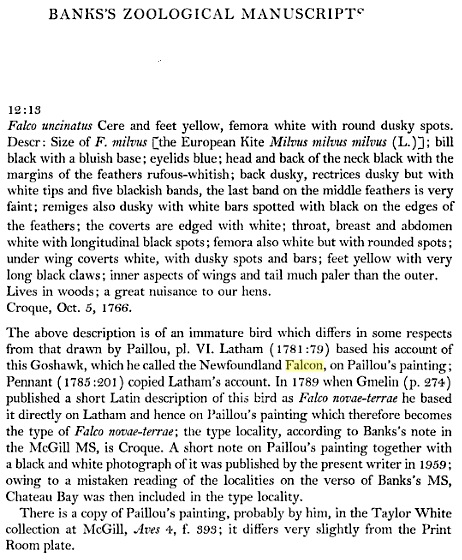 Latham's description (above) borrowed from banks. His artist made a plate of the mysterious "Newfoundland Falcon"but this was based on a drawing from Banks. Typically drawings and plate were of poor quality and often made identifying the species difficult.
If British interests were not enough, both French and Spanish Royalty were extreme enthusiasts of the sport. So much so that Charles VIII of France in 1494 commissioned a lengthy book entitled The Art of Falconry that formed the basis of modern Ornithology. Beautifully written and magnificently illustrated throughout by lifelike pictures of birds, this manuscript demonstrates the perfection of book design achieved in France in the late Fifteenth Century. The Royalty and Nobles of Spain and France all kept falconers and many birds. For example King Louis the XI of France kept over 100 falconers and many many birds.
|
Many old books (including the historical rolls of the British Parliament including those concerning trade with the first British Colony - Newfoundland) are now available on-line allowing "within document searching".
Townsend, Charles, Wendell, 1911. Captain Cartwright and his Labrador Journal. http://archive.org/details/captaincartwrigh00cart
Jean Vanes 1979 (ed.) Documents illustrating the overseas trade of Bristol in the sixteenth century.
Hakluyt V13 chapter 11 A briefe note concerning the voyage of M. George Drake of Apsham to Isle of Ramea in the aforesayd yere 1593.
http://ebooks.adelaide.edu.au/h/hakluyt/voyages
Hakluyt Vol 13 chapter 5 : A briefe and summary discourse vpon the intended voyage to the hithermost parts of America: written by Captaine Carlile in April, 1583. for the better inducement to satisfie such Merchants of the Moscouian companie and others, as in disbursing their money towards the furniture of the present charge, doe demand forthwith a present returne of gaine, albeit their said particular disbursements are required but in very slender summes, the highest being 25. li. the second at 12. li. 10. s. and the lowest at 6. pound fiue shilling.
http://ebooks.adelaide.edu.au/h/hakluyt/voyages/v13/
Anspache, L.A. 1918 A History of Newfoundland (London).
http://www.nosracines.ca/e/toc.aspx?id=1318
Haklyut, http://ebooks.adelaide.edu.au/h/hakluyt
/index.html note Hakluyt's America Part II: Sir George Peckham's True Report of the Late Discoveries (print 1583). --suggesting how good the falconry could be and of the various hawks and hawking game. Link at : http://ebooks.adelaide.edu.au/h/hakluyt/voyages/v13
Lysaght, A.M. 1971 Joseph Banks in Newfoundland and Labrador 1766: His Diary, Manuscripts, and Collections
Sir Anthony Weldon 1650. Court and Character of King James I
Latham, John 1821 - 1828. A General History of Birds. Vol. 1 Publisher Jacob and Johnson, for the author, 1821
Latham, John 1781. A General Synopsis of Birds. London Published by Benj. White http://ia600202.us.archive.org/20/items/cihm_182
15/cihm_18215.pdf?temp-new-window-replacement=true
Pannant, Thomas, 1784-1787. Arctic Zoology Vol 2 London
Martinet, F.-N. Plates for M-J Brisson 1760. Ornithology. (some 220 plates by some accounts but 973 bird plates were drawn and engraved by F.N. Martinet under the supervision of E.L. Daubenton ('D le cadet'), who was a relation of L.J.M. Daubenton, Buffon's collaborator in the Histoire naturelle--Cf. Anker, Bird books, p. 108. An example of these amazing plates on-line is linked below.
http://ia600605.us.archive.org/35/items/planchese
nlumin01mart/planchesenlumin01mart.pdf?te
mp-new-window-replacement=true
William A. Montevecchi, Leslie M. Tuck 1987 Newfoundland Birds: Exploitation, Study, Conservation. Nuttall Ornithological Club (a similar work spanning the french and spanish records has not been undertaken despite that these cultures occupied most of Newfoundand for longer than the British egs Count De Buffon aka Georges- Louis Leclerc, Reaumur, Brisson, etc).
Charles Turner, 1898 "The Revival of Falconry" Outing Magazine (Vol 31 05)
http://www.la84foundation.org/SportsLibrary/Outing
/Volume_31/outXXXI05/outXXXI05h.pdf
Mackie, J., D. 1966 The Early Tudors 1485-1558. Claredon, Oxford
A brief History of Falconry in North America is supplied by Kent Carnie for the UNESCO World Heritage presentation and can be seen at:
